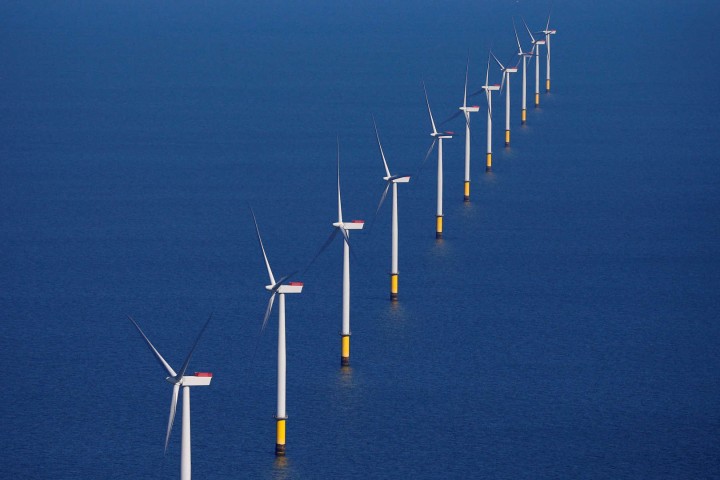Global renewable capacity surges 4.7% in 2021 as countries focus on clean energy projects

© Phil Noble Wind turbines off the coast of the UK. Globally, offshore wind capacity doubled in 2021, according to Rystand Energy. Reuters
The total new renewable capacity installed reached 227 gigawatts this year, mainly driven by residential solar, offshore wind projects, battery and other forms of stored energy, according to a report from Norway-based consultancy Rystad Energy. Residential solar outpaced commercial and industrial capacity additions for the first time, while new offshore wind installations doubled compared to 2020.
“The renewable energy industry is facing some of its most significant challenges yet over the short term, but the future has never looked brighter with new and aggressive commitments from governments and companies alike,” Gero Farruggio, head of renewables research at Rystad Energy, said.
“The carbon-neutral pledges set forth at the Cop26 climate conference in Glasgow this year will help spur major growth in the coming years.”
A number of countries in the Middle East region have pledged to become carbon neutral in the coming decades, including the UAE, Saudi Arabia and Bahrain.
The UAE, which aims to reach net zero by 2050, plans to invest $160 billion over the next three decades to hasten renewable energy development.
New renewable power capacity is projected to rise to 290 gigawatts this year, setting a “fresh all-time record for new installations”, according to a separate report by the International Energy Agency earlier this month.
"The record-breaking additions of 290 gigawatts of solar, wind and other renewables are yet another sign that a New Global Energy Economy is emerging," Fatih Birol, IEA’s executive director, said.
Residential solar capacity grew more than 30 per cent in 2021 to 25.2 gigawatts, while offshore wind capacity doubled during the year, the Rystad report said. Hydrogen electrolyser capacity and utility battery storage also rose during the year.
“Looking ahead, renewable capacity is expected to skyrocket to over 270 gigawatts of installed capacity in 2022, driven primarily by solar and hydrogen expansion,” Rystad Energy said.
Onshore wind projects, however, declined during the period, due to the winding down of Chinese subsidies which are projected to cause a 40-gigawatt drop in capacity for the country, according to the report.
Onshore wind installations globally are expected to fall to around 85 gigawatts in 2021 – a 20-gigawatt drop year-over-year – and a further 15 gigawatts drop in 2022.
The trend, however, is expected to be short-lived, as demand for renewable generation soars in the wake of clean energy targets set by different countries and new projects start, Rystad Energy said.
The report also pointed out that global green hydrogen project announcements have accelerated this year, as countries focus on cutting emissions. A total of 245 gigawatts of hydrogen electrolyser facilities have been announced worldwide in 2021 – six times the levels seen in 2020.
Green hydrogen is manufactured from electrolysis, which involves splitting water molecules into hydrogen and oxygen, using renewable energy.
The UAE and other countries around the region have formulated plans to introduce hydrogen into the energy mix and tap into the clean fuel’s potential.
State entities Adnoc, Mubadala and ADQ formed an alliance this year to develop a hydrogen economy in the UAE.
While the hydrogen boom is well under way, the real game-changer for the energy transition globally will come when the cost of green hydrogen production is reduced, according to a separate report from Wood Mackenzie.
Globally, the hydrogen project pipeline has grown seven-fold since December 2020 as the world focuses on energy transition, according to the study. But most projects are at an early development stage, with the bulk of new projects advanced during the second quarter of this year.
Globally, the size of the hydrogen industry is expected to hit $183bn by 2023, up from $129bn in 2017, according to Fitch Solutions. French investment bank Natixis estimates that investment in hydrogen will exceed $300bn by 2030.
Clean energy generation has picked up pace around the world, boosted by the collective will to build back better after the Covid-19 pandemic underscored the urgent need for sustainable and equitable growth.
Many countries, including major oil-dependent nations, have pledged to reach net zero emissions by the middle of the century as they strive to reduce emissions and mitigate climate change.

